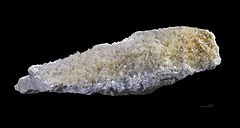Talc
| Talc | |
|---|---|

Crystals of talc
|
|
| General | |
| Category | Silicate mineral |
|
Formula (repeating unit) |
Mg3Si4O10(OH)2 |
| Strunz classification | 9.EC.05 |
| Crystal system | Monoclinic or Triclinic |
| Crystal class | Either prismatic (2m) or pinacoidal (1) |
| Unit cell | a = 5.291 Å, b = 9.173 Å c = 5.290 Å; α = 98.68° β = 119.90°, γ = 90.09°; Z = 2 or a = 5.287 Å, b = 9.158 Å c = 18.95 [Å], β = 99.3°; Z = 4 |
| Identification | |
| Color | Light to dark green, brown, white, grey |
| Crystal habit | Foliated to fibrous masses, rare as platey to pyramidal crystals |
| Cleavage | Perfect on {001} basal cleavage |
| Fracture | Flat surfaces (not cleavage), fracture in an uneven pattern |
| Tenacity | Sectile |
| Mohs scale hardness | 1 (defining mineral) |
| Luster | Waxlike or pearly |
| Streak | White to pearl black |
| Diaphaneity | Translucent |
| Specific gravity | 2.58 to 2.83 |
| Optical properties | Biaxial (-) |
| Refractive index | nα = 1.538 – 1.550 nβ = 1.589 – 1.594 nγ = 1.589 – 1.600 |
| Birefringence | δ = 0.051 |
| Pleochroism | Weak in dark varieties |
| Ultraviolet fluorescence | Short UV=orange yellow, long UV=yellow |
| References | |
Talc is a clay mineral composed of hydrated magnesium silicate with the chemical formula H2Mg3(SiO3)4 or Mg3Si4O10(OH)2. In loose form, it, along with corn starch, was one of the most widely used substances known as baby powder (in the case of talc, often called simply talcum powder; see litigation.) It occurs as foliated to fibrous masses, and in an exceptionally rare crystal form. It has a perfect basal cleavage, and the folia are not elastic, although slightly flexible.
Mohs scale of mineral hardness, based on scratch hardness comparison, defines value 1 as the hardness of talc. As such, talc can easily be scratched by a fingernail. Talc has a specific gravity of 2.5–2.8, a clear or dusty luster, and is translucent to opaque. Talc is not soluble in water, but is slightly soluble in dilute mineral acids. Its color ranges from white to grey or green and it has a distinctly greasy feel. Its streak is white.
Soapstone is a metamorphic rock composed predominantly of talc.
The word "talc" derives from Medieval Latin talcus, which in turn originates from Arabic: طلق ṭalq which in turn was derived from Persian: تالک tālk. In the ancient times, the word was used for various related minerals, including talc, mica, and selenite.
...
Wikipedia
